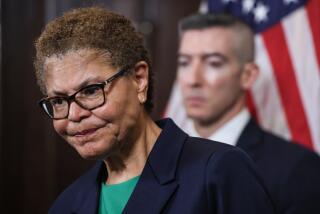In an Era of Lean Budgets, Maintenance Is Often Swept Aside
- Share via
Gordon H. Beatty Elementary School in Buena Park teaches a grim lesson in government austerity.
The 31-year-old school has a declining ventilation system that periodically breaks down. But a new air-conditioning unit would cost $42,000, a sum that the Buena Park School District simply cannot afford. So whenever the equipment fails, the district sends out workers to make temporary repairs.
“It really seems like a waste,” said George Cottrell, the district’s assistant superintendent for administrative services.
“Heck, over five years, it will cost $42,000 just to keep the darn thing running.”
Other school districts and government agencies are facing the same situation as they struggle to maintain equipment and facilities in a time of tight budgets and increased competition for public dollars.
Complicated repairs, routine maintenance and custodial services are often overlooked by elected officials who want to focus resources on more high-profile services such as reducing class sizes and improving police patrols.
“Maintenance does not have sex appeal,” said Paul Reed, assistant superintendent for the Irvine Unified School District.
“It’s always a hard sell at budget time because there is a reluctance to devote money to [items] that may not have a direct connection to students.”
As a result, officials spend their limited maintenance budgets on only the most critical needs, putting off less urgent jobs such as replacing worn carpeting and repainting bathrooms.
Experts warn that maintenance needs will grow in coming years, though, as scores of public buildings erected in the 1950s and 60s begin to show their age.
“Orange County’s infrastructure problems aren’t as severe as in an older city like San Francisco, but they still need to be addressed,” said John Kirlin, a professor of public administration at USC.
*
School districts with growing enrollments now have the added maintenance headache of reopening long-dormant school sites, which often require major repairs as well as modifications to accommodate new technology.
“A lot of people think it’s as easy as turning the lights back on and letting the kids in,” said Tracy Pellman, a trustee with the Ocean View School District. “But it takes a lot of work.”
For county government, the 1994 bankruptcy made matters worse. Severe budget cuts forced the county to curtain its once-meticulous preventive maintenance program, in which workers regularly inspected and repaired hundreds of elevators, plumbing and lighting systems.
Officials fear that without regular maintenance, equipment might break down prematurely, costing the county more money in the long run than preventive maintenance.
“It’s like with an automobile. You are supposed to change the oil every 5,000 miles,” said Robert A. Griffith, director of the county General Services Agency.
“But if you don’t change it for 20,000 miles, you’ll have a big problem.”
County supervisors last month allocated $800,000 to improve maintenance efforts. Griffith said the money will be used on elevators and other equipment “where the costs of breakdown is really high.”
*
Most school districts, however, are still feeling the pinch.
In Buena Park, school officials project they will need $6 million over the next decade for a variety of maintenance projects, including resurfacing playgrounds and repainting classrooms.
But the district expects to have only $2 million available.
Lacking the money to purchase more efficient products, educators say they must continue to rely on equipment like old-fashioned fluorescent ceiling lights.
The district recently used a federal grant to replace the aging light fixtures at one school with a new energy-efficient model.
The change reduced the school’s electric bill, and the new fixtures use much cheaper light bulbs than the old ones.
Officials want to replace the fixtures at other schools, but don’t have the money.
“You want to put in the things that cost less, but you can’t,” Cottrell said. “It really doesn’t make sense.”
(BEGIN TEXT OF INFOBOX / INFOGRAPHIC)
Roads Not Taken
Faced with tight budgets, many local governments can complete only the most critical maintenance projects. Here are some jobs being put off:
* Replacing worn and torn carpets.
* Repaving school playground areas and walkways.
* Painting classrooms and restrooms.
* Doing preventive maintenance of big-ticket items such as elevators.
* Replacing outdated or inefficient equipment such as air conditioners.
Source: Los Angeles Times reports
Researched by SHELBY GRAD / For The Times
Los Angeles Times
More to Read
Sign up for Essential California
The most important California stories and recommendations in your inbox every morning.
You may occasionally receive promotional content from the Los Angeles Times.














